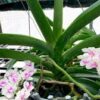# Stress Reduction Techniques for Dendrobium Anosmum (Đai Châu Orchids)

Dendrobium anosmum, commonly known as Đai Châu orchids, are celebrated not only for their stunning blooms and enchanting fragrances but also for their unique resilience. However, like all plants, they can experience stress due to environmental changes, pests, or improper care. Understanding how to alleviate stress for these orchids is essential for their health and longevity. This comprehensive guide explores various methods to reduce stress in Dendrobium anosmum, ensuring they thrive in your care.
## Understanding Plant Stress
### What is Plant Stress?
Plant stress refers to any condition that adversely affects the growth and development of a plant. It can be caused by various factors, including:
– **Environmental Stress**: Changes in light, temperature, humidity, and water availability.
– **Biological Stress**: Pests and diseases that harm plant health.
– **Nutritional Stress**: Deficiencies or imbalances in essential nutrients.
Recognizing the signs of stress in Dendrobium anosmum is the first step toward effective intervention. Common indicators of stress include yellowing leaves, stunted growth, wilting, and reduced flowering.
### The Importance of Reducing Stress
Reducing stress in Dendrobium anosmum is crucial for several reasons:
– **Promotes Healthy Growth**: Stress-free plants are more likely to grow vigorously and produce abundant blooms.
– **Enhances Resilience**: Healthy orchids are better equipped to withstand environmental fluctuations and pest infestations.
– **Improves Aesthetics**: Stress reduction leads to lush foliage and vibrant flowers, enhancing the beauty of your living space.
With these benefits in mind, let’s explore effective stress reduction techniques tailored to Dendrobium anosmum.
## Optimal Care Practices
### 1. Proper Watering Techniques
Watering is one of the most critical aspects of orchid care. Both overwatering and underwatering can lead to stress.
#### Best Practices for Watering
– **Check Soil Moisture**: Before watering, always check the potting medium. Allow the top inch of the medium to dry out between waterings.
– **Use Room Temperature Water**: Water your orchids with room-temperature water to avoid shocking their roots.
– **Water Thoroughly**: When you water, do so thoroughly, allowing excess water to drain out of the bottom of the pot. This ensures that the roots receive adequate moisture without sitting in water, which can lead to rot.
### 2. Ideal Lighting Conditions
Light is a crucial factor for the health of Dendrobium anosmum. Insufficient or excessive light can cause stress.
#### Best Practices for Lighting
– **Bright, Indirect Light**: Position your orchids near east or west-facing windows where they can receive bright, indirect sunlight. Avoid direct sunlight, as it can scorch the leaves.
– **Supplemental Lighting**: In low-light conditions, consider using grow lights to ensure your orchids receive adequate light, especially during the shorter days of winter.
### 3. Humidity Management
Dendrobium anosmum thrives in humid environments. Low humidity can lead to stress and hinder growth.
#### Best Practices for Humidity
– **Maintain Humidity Levels**: Aim for humidity levels between 50% and 70%. You can use a hygrometer to monitor humidity in your growing area.
– **Use Humidifiers**: In dry indoor environments, especially during winter, consider using a humidifier to maintain adequate humidity levels.
– **Grouping Plants**: Placing multiple orchids close together can create a microclimate with higher humidity, benefiting all plants involved.
### 4. Temperature Regulation
Temperature fluctuations can also contribute to plant stress. Dendrobium anosmum prefers specific temperature ranges for optimal growth.
#### Best Practices for Temperature
– **Ideal Temperature Range**: Aim for daytime temperatures between 20°C to 30°C (68°F to 86°F) and slightly cooler at night (around 15°C to 20°C or 59°F to 68°F).
– **Avoid Sudden Changes**: Protect your orchids from sudden temperature changes caused by drafts, air conditioning, or heating vents.
## Nutritional Support
### 5. Balanced Fertilization
Nutritional stress can arise from deficiencies in essential nutrients. A balanced fertilization regimen can help alleviate this stress.
#### Best Practices for Fertilization
– **Use Orchid-Specific Fertilizers**: Choose a balanced fertilizer formulated specifically for orchids, such as a 30-10-10 or 20-20-20 blend.
– **Fertilizing Schedule**: During the growing season (spring and summer), fertilize every two weeks. In the dormant season (fall and winter), reduce fertilization to once a month or as needed.
– **Dilution**: Always dilute the fertilizer to half the recommended strength to avoid over-fertilizing, which can stress the plant.
### 6. Soil and Potting Medium
The right potting medium is essential for healthy root development and stress reduction.
#### Best Practices for Potting
– **Choose a Well-Draining Medium**: Dendrobium anosmum prefers a potting mix that allows for excellent drainage, such as a combination of bark, sphagnum moss, and perlite.
– **Repotting**: Repot your orchids every 1-2 years or when the potting medium breaks down. This helps ensure healthy root growth and prevents root rot.
## Pest and Disease Management
### 7. Regular Inspections
Pest infestations and diseases can cause significant stress to Dendrobium anosmum. Regular inspections are key to early detection and management.
#### Best Practices for Pest Management
– **Visual Inspections**: Regularly check your orchids for signs of pests such as aphids, mealybugs, or scale insects. Look for discolored leaves, webbing, or sticky residue.
– **Quick Action**: If pests are detected, act promptly by using insecticidal soap or neem oil to treat the infestation. Follow the manufacturer’s instructions for application.
### 8. Preventative Measures
Implementing preventative measures can help protect your orchids from pests and diseases.
#### Best Practices for Prevention
– **Good Air Circulation**: Ensure good air circulation around your orchids by avoiding overcrowding. This reduces humidity levels that favor fungal infections.
– **Sanitize Tools**: Always sanitize your gardening tools to prevent the spread of diseases between plants.
## Stress Relief Techniques
### 9. Providing Rest Periods
Dendrobium anosmum, like all plants, benefit from rest periods during dormancy. Understanding their natural cycles can help reduce stress.
#### Best Practices for Resting
– **Recognize Dormancy**: During the dormant season (usually late fall to winter), reduce watering and fertilization to allow your orchids to rest and conserve energy.
– **Adjust Light**: If possible, provide slightly lower light levels during dormancy, mimicking natural conditions.
### 10. Supportive Environment
Creating a supportive environment is crucial for reducing stress in your orchids.
#### Best Practices for Environment
– **Consistent Care**: Maintain a consistent care routine to help your orchids feel secure. Consistency in watering, fertilizing, and lighting reduces stress caused by sudden changes.
– **Observation**: Pay attention to your orchids’ responses to changes in their environment. Adjust care practices based on their needs and stress signals.
### 11. Repotting as Needed
While repotting can be stressful for orchids, it is often necessary for their health. Knowing when and how to repot can help mitigate stress.
#### Best Practices for Repotting
– **Signs of Repotting Need**: Repot your orchids when you notice roots growing out of the pot, the potting medium breaking down, or when the plant becomes top-heavy.
– **Gentle Handling**: When repotting, handle the roots gently and avoid excessive disruption to minimize stress.
## Enhancing Overall Plant Health
### 12. Companion Planting
Companion planting involves placing Dendrobium anosmum alongside compatible plants to create a supportive environment.
#### Best Practices for Companion Planting
– **Choose Compatible Plants**: Consider pairing your orchids with humidity-loving plants, such as ferns or peace lilies, that can help maintain moisture levels.
– **Diverse Ecosystem**: Creating a diverse ecosystem can improve overall plant health and resilience, reducing stress for all plants involved.
### 13. Utilizing Natural Remedies
Natural remedies can support the health of Dendrobium anosmum and help alleviate stress.
#### Best Practices for Natural Remedies
– **Organic Pest Control**: Use natural pest control methods, such as diatomaceous earth, to deter pests without harming the orchids.
– **Natural Fertilizers**: Incorporate organic fertilizers like compost tea or fish emulsion to provide nutrients while promoting a healthy soil ecosystem.
### 14. Mindful Care
Practicing mindfulness in your care routine can enhance your connection with your orchids and reduce stress for both you and the plants.
#### Best Practices for Mindful Care
– **Engage with Your Plants**: Spend time observing your orchids, noting any changes in their appearance or behavior. This can help you respond more effectively to their needs.
– **Create a Care Ritual**: Establish a routine that includes checking on your orchids, watering, and fertilizing. This mindful practice can enhance your appreciation for their beauty and promote stress reduction.
## Seasonal Considerations
### 15. Adapting Care to Seasons
Different seasons bring unique challenges for Dendrobium anosmum. Adapting your care routine to seasonal changes is vital for reducing stress.
#### Best Practices for Seasonal Care
– **Spring and Summer**: During the growing season, increase watering and fertilization to support active growth. Monitor for pests more closely as they may be more prevalent.
– **Fall and Winter**: As temperatures drop and light levels decrease, reduce watering and fertilization. Provide cooler
temperatures to simulate their natural dormancy.
## Conclusion
Dendrobium anosmum, or Đai Châu orchids, are exquisite plants that can flourish in your care with the right stress reduction techniques. By understanding the causes of plant stress and implementing effective care practices, you can create an environment that promotes their health and vitality.
Incorporate these methods into your routine to ensure that your Dendrobium anosmum not only survive but thrive, bringing beauty and joy to your home. Remember that each orchid is unique, and observing their responses to care will guide you in providing the best possible support. With dedication and knowledge, you can cultivate these stunning orchids and enjoy their splendor for years to come.

